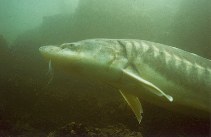| Family: |
Acipenseridae (Sturgeons), subfamily: Acipenserinae |
| Max. size: |
200 cm TL (male/unsexed); max.weight: 25 kg |
| Environment: |
demersal; freshwater; brackish; marine; depth range 10 - 40 m, anadromous |
| Distribution: |
Europe: Adriatic Sea and its tributaries between Po (Italy) and Buna (Albania) drainages. Recorded from Corfu; present in lowermost part of Adriatic rivers from Soca to Drin. Records from Tyrrhenian slope of Italy, Spain and France are erroneous. |
| Diagnosis: |
Dorsal spines (total): 0-0; Dorsal soft rays (total): 36-48; Anal soft rays: 24-31. Snout moderate, very broad and rounded at tip. Lower lip continuous, interrupted at center. Barbels nearer to tip of snout than to mouth and not touching it. Five rows of scutes, dorsal 10-14 (the middle ones deeper and usually larger than those at front), lateral 32-42 on each side, ventral 8-11 on each side, with no smaller plates between dorsal and lateral rows. Back is olivaceous brown, flanks lighter, belly white. |
| Biology: |
Occurs in the sea close to shore and estuaries, not entering pure marine waters. In freshwater, it inhabits large deep rivers (Ref. 59043). A long-lived species which is found mainly over sand and mud. Feeds on bottom-living invertebrates and small fishes. Reproduction takes place from May to July. Is threatened by habitat destruction, pollution and overfishing (Ref. 26100). The flesh is used for food (Ref. 6866) and eggs used for caviar production (Ref. 128183). |
| IUCN Red List Status: |
Critically Endangered (CR); Date assessed: 14 September 2019 (A2bcde) Ref. (130435)
|
| Threat to humans: |
harmless |
Source and more info: www.fishbase.org. For personal, classroom, and other internal use only. Not for publication.

